
Rabaul is a township in the East New Britain province of Papua New Guinea, on the island of New Britain. It lies about 600 kilometres to the east of the island of New Guinea. Rabaul was the provincial capital and most important settlement in the province until it was destroyed in 1994 by falling ash from a volcanic eruption in its harbor. During the eruption, ash was sent thousands of metres into the air, and the subsequent rain of ash caused 80% of the buildings in Rabaul to collapse. After the eruption the capital was moved to Kokopo, about 20 kilometres (12 mi) away. Rabaul is continually threatened by volcanic activity, because it is on the edge of the Rabaul caldera, a flooded caldera of a large pyroclastic shield volcano.

German New Guinea consisted of the northeastern part of the island of New Guinea and several nearby island groups and was the first part of the German colonial empire. The mainland part of the territory, called Kaiser-Wilhelmsland, became a German protectorate in 1884. Other island groups were added subsequently. The Bismarck Archipelago, and the North Solomon Islands were declared a German protectorate in 1885. The Caroline Islands, Palau, and the Mariana Islands were bought from Spain in 1899. German New Guinea annexed the formerly separate German Protectorate of Marshall Islands, which also included Nauru, in 1906. German Samoa, though part of the German colonial empire, was not part of German New Guinea.

The Territory of Papua comprised the southeastern quarter of the island of New Guinea from 1883 to 1975. In 1883, the Government of Queensland annexed this territory for the British Empire. The United Kingdom Government refused to ratify the annexation but in 1884 a protectorate was proclaimed over the territory, then called British New Guinea. There is a certain ambiguity about the exact date on which the entire territory was annexed by the British. The Papua Act 1905 recites that this happened "on or about" 4 September 1888. On 18 March 1902, the Territory was placed under the authority of the Commonwealth of Australia. Resolutions of acceptance were passed by the Commonwealth Parliament, which accepted the territory under the name of Papua.
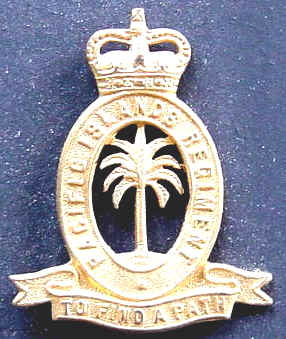
The Royal Pacific Islands Regiment (RPIR) is an infantry regiment of the Papua New Guinea Defence Force (PNGDF). The regiment is descended from the Australian Army infantry battalions formed from native soldiers and Australian officers and non-commissioned officers in the territories of Papua and New Guinea during World War II to help fight against the Japanese. Disbanded after the war, the regiment was re-raised in 1951 as part of the Australian Army and continued to serve until Papua New Guinea gained its independence in 1975, when it became part of the PNGDF. Today, the RPIR consists of two battalions and has seen active service in Vanuatu, Bougainville and the Solomon Islands.

Morobe Province is a province on the northern coast of Papua New Guinea. The provincial capital and largest city is Lae. The province covers 33,705 km2, with a population of 674,810, and since the division of Southern Highlands Province in May 2012 it is the most populous province. It includes the Huon Peninsula, the Markham River, and delta, and coastal territories along the Huon Gulf. The province has nine administrative districts. At least 101 languages are spoken, including Kâte and Yabem language. English and Tok Pisin are common languages in the urban areas, and in some areas pidgin forms of German are mixed with the native language.
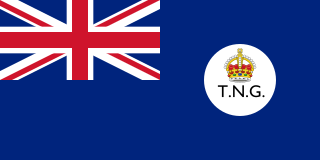
The Territory of New Guinea was an Australian-administered League of Nations and then United Nations trust territory on the island of New Guinea from 1914 until 1975. In 1949, the Territory and the Territory of Papua were established in an administrative union by the name of the Territory of Papua and New Guinea. That administrative union was renamed as Papua New Guinea in 1971. Notwithstanding that it was part of an administrative union, the Territory of New Guinea at all times retained a distinct legal status and identity until the advent of the Independent State of Papua New Guinea.

The Territory of Papua and New Guinea , officially the Administrative Union of the Territory of Papua and the Territory of New Guinea, was established by an administrative union between the Australian-administered territories of Papua and New Guinea in 1949. In December 1971, the name of the Territory changed to "Papua New Guinea" and in 1975 it became the Independent State of Papua New Guinea.
The Australian School of Pacific Administration (ASOPA) was a tertiary institution established by the Australian Government to train administrators and later school teachers to work in Papua New Guinea. It became the International Training Institute (ITI) in 1973 and provided management training for professionals from developing countries in the Pacific, Asia, Africa and the Caribbean. After a period as a base for consultants operating in the South Pacific for the Australian Development Assistance Bureau, it closed in late 1997.
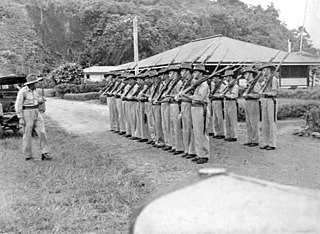
The New Guinea Volunteer Rifles (NGVR) was an infantry battalion of the Australian Army. It was initially raised as a unit of the Militia from white Australian and European expatriates in New Guinea upon the outbreak of the Second World War in 1939, before being activated for full-time service following the Japanese landings in early 1942. NGVR personnel then helped rescue survivors of Lark Force from Rabaul in February and March 1942. Between March and May, the NGVR monitored the Japanese bases which had been established in the Huon Gulf region, being the only Allied force in the area until the arrival of Kanga Force at Wau in May. The battalion subsequently established observation posts overlooking the main approaches and reported on Japanese movements.
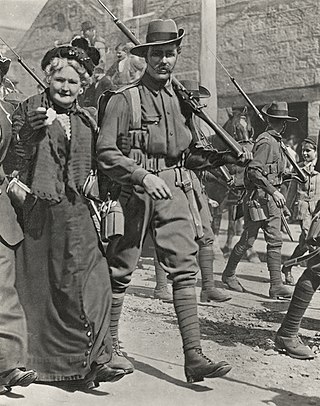
The Battle of Bita Paka was fought south of Kabakaul, on the island of New Britain, and was a part of the invasion and subsequent occupation of German New Guinea by the Australian Naval and Military Expeditionary Force (AN&MEF) shortly after the outbreak of the First World War. Similar to New Zealand's operation against German Samoa in August, the main target of the operation was a strategically important wireless station—one of several used by the German East Asia Squadron—which the Australians believed to be located in the area. The powerful German naval fleet threatened British interests and its elimination was an early priority of the British and Australian governments during the war.

New Guinea Force was a military command unit for Australian, United States and native troops from the Territories of Papua and New Guinea serving in the New Guinea campaign during World War II. Formed in April 1942, when the Australian First Army was formed from the Australian I Corps after it returned from the Middle East, it was responsible for planning and directing all operations within the territory up until October 1944. General Headquarters Southwest Pacific Area Operational Instruction No.7 of 25 May 1942, issued by Commander-Allied-Forces, General Douglas MacArthur, placed all Australian and US Army, Air Force and Navy Forces in the Port Moresby Area under the control of New Guinea Force. Over the course of its existence, New Guinea Force was commanded by some of the Australian Army's most notable commanders, including Sydney Rowell, Sir Edmund Herring and Sir Leslie Morshead.

The Papuan Infantry Battalion (PIB) was a unit of the Australian Army raised in the Territory of Papua for service during the Second World War. Formed in early 1940 in Port Moresby to help defend the territory in the event of a Japanese invasion, its soldiers were primarily Papuan natives led by Australian officers and non-commissioned officers. Following the outbreak of the Pacific War, the PIB served in many of the Allied campaigns in New Guinea; however, due to the nature of its role its sub-units mainly operated separately, attached to larger Australian and US Army units and formations. Slow in forming, the first members of the PIB were not officially posted in until March 1941. By 1942 it consisted of only three companies, all of which were under-strength and poorly equipped. It was subsequently employed on scouting, reconnaissance and surveillance patrols against the Japanese, where the natural bushcraft of its native soldiers could be used to their advantage. The PIB was sent forward in June 1942 to patrol the northern coast of Papua and was dispersed over a wide area. These small parties were the first to make contact with the Imperial Japanese forces upon their landing in Papua, before participating in the Kokoda Track campaign. As part of Maroubra Force, the PIB fought alongside the Australian 39th Battalion at Kokoda, Deniki, and Isurava as the Japanese forced them back along the Kokoda track, but was withdrawn before the campaign finally turned in favour of the Australians.
The 2/7th Commando Company was one of 12 independent companies or commando squadrons raised by the Australian Army during the Second World War. Raised in May 1942, as the 2/7th Independent Company, the 2/7th served in New Guinea in 1943 during the Salamaua–Lae campaign before being redesignated as the 2/7th Commando Squadron when it was combine with two other commando squadrons to become part of the 2/6th Cavalry (Commando) Regiment. Later at the end of 1944, it was sent to New Guinea again, where it took part in the Aitape–Wewak campaign. Following the end of the war, the squadron was returned to Australia and disbanded early in 1946.
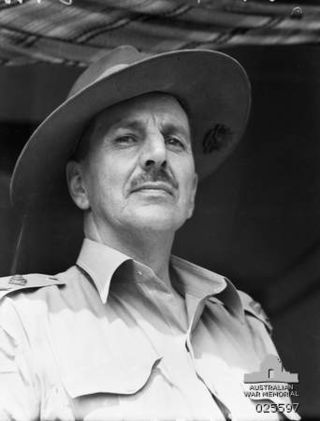
Major General Basil Moorhouse Morris, was an Australian Army officer. He served in both the First and Second World Wars. In 1942, he was the Australian military administrator at Port Moresby at the start of the Imperial Japanese advance along the Kokoda Track after the invasion of Buna-Gona and successfully delayed the Japanese advance until units of the Second Australian Imperial Force arrived.

ANGAU Memorial Hospital is a major hospital in Lae, Papua New Guinea. Named after an Australian Army unit that was responsible for the civil administration of the Territory of Papua and the Mandated Territory of New Guinea, the hospital provides in-patient and specialist medical services to people in the Sepik, Madang and Morobe provinces. In 2013–14, the Australian government announced that it would contribute to the hospital's redevelopment as part of a deal with the PNG government relating to the resettlement of asylum seekers.
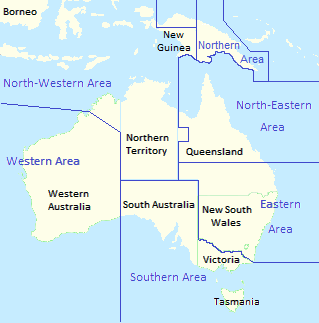
Area commands were the major operational and administrative formations of the Royal Australian Air Force (RAAF) between 1940 and 1954. Established in response to the outbreak of World War II, they underpinned the Air Force's geographically based command-and-control system for the duration of the conflict and into the early years of the Cold War, until being superseded by a functional control system made up of Home, Training, and Maintenance Commands.

The New Guinea Air Warning Wireless, also known as the "New Guinea Air Warning Wireless Company", "NGAWW", or "The Spotters", was a unique signals unit of the Australian Army formed in January 1942 in Port Moresby, Territory of Papua, during World War II, to provide early warning of Japanese air attack, and subsequently providing surveillance of shipping and ground-based troops. During the first month of operations 16 stations were established, with positions set up along the Papuan coast as well as in the mountains near Port Moresby. They often operated behind Japanese lines and were at risk of being captured by the Japanese due to the nature of their operations, while a number of outstations were over-run and the men manning them killed. By the end of 1942 the company was maintaining 61 operational stations and had a strength of 180 men.
The 6th Machine Gun Battalion was a battalion of the Australian Army that was raised for service during World War II. Formed in late 1942 from the machine gun companies of several infantry battalions, the 6th Machine Gun Battalion undertook training on the New South Wales south coast before being deployed to New Guinea where they took part in the Markham and Ramu Valley – Finisterre Range campaign, defending the airfield at Gusap, and undertaking patrols. In early 1944, the battalion returned to Australia and over the course of the year was disbanded, with its personnel being sent to other units as reinforcements. Many of these personnel then saw combat in Borneo in 1945.

During the Second World War, Allied logistics in Papua played a crucial role in bringing the Kokoda Track campaign to a successful conclusion. "The great problem of warfare in the Pacific", General Douglas MacArthur declared, "is to move forces into contact and maintain them. Victory is dependent upon solution to the logistic problem."
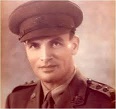
Captain Herbert Thomson "Bert" Kienzle was an Australian soldier and plantation owner from the Territory of Papua. He is notable for his contribution as officer in charge of native labour supporting Australian forces fighting along the Kokoda Track. He identified and named the dry lake beds, Myola, that were to become an important supply dropping area and staging point during the Kokoda Track campaign. In later life, he was recognised for his contribution to the development of Papua New Guinea.

















